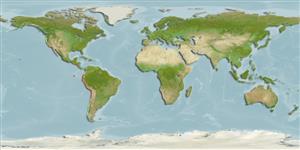Klassifizierung / Names
Namen | Synonyme | Catalog of Fishes(Gattung, Arten) | ITIS | CoL | WoRMS | Cloffa
Environment: milieu / climate zone / depth range / distribution range
Ökologie
seewasser demersal; tiefenbereich 80 - 150 m (Ref. 93007). Tropical
Southeast Pacific: off Peru to Costa Rica.
Size / Gewicht / Alter
Maturity: Lm ? range ? - ? cm
Max length : 14.2 cm (female)
Kurzbeschreibung
Morphologie | Morphometrie
Rückenflossenweichstrahlen (insgesamt): 83-87; Afterflossenweichstrahlen: 51 - 54; Wirbelzahl: 54 - 56. This species is distinguished from it congeners by the following characters: gill filaments on anterior arch is 4-5 times the length of the developed rakers; a pair of very small, subdermal, closely set spines on frontal plate above and behind eyes, absence of spine on ethmoid; anterior arch with 2-3 developed rakers, not much longer than spiny knobs; gill filaments on anterior arch 4-5 times length of developed rakers; palatines 2-4 tooth rows; prolonged pectoral peduncle adnate to body; vertebrae, precaudal 14-16 and total 54-56; fin rays, D 83-87, A 51-54, caudal 12-13, pectoral 17-19 (Ref. 93007).
Rare species, known from two specimens (Ref. 34024). A viviparous species living on the lower part of the continental shelf (80-150 m). Four examined female specimens are with well-developed eggs but apparently no embryos. Sections of ripe testes show that the spermatozoans are arranged in spermatophores (Ref. 93007).
Life cycle and mating behavior
Geschlechtsreife | Fortpflanzung | Ablaichen | Eier | Fecundity | Larven
Nielsen, J.G., W. Schwarzhans and D.M. Cohen, 2012. Revisions of Hastatobythites and Saccogaster (Teleostei, Bythitidae) with three new species and a new genus. Zootaxa 3579:1-36. (Ref. 93007)
IUCN Rote Liste Status (Ref. 130435)
Bedrohung für Menschen
Harmless
Nutzung durch Menschen
Fischereien: nicht kommerziell
Mehr Information
NamenSynonymeMetabolismusRäuberÖkotoxikologieFortpflanzungGeschlechtsreifeAblaichenSpawning aggregationFecundityEierEientwicklung
Alter/GrößeWachstumLänge-GewichtLänge-LängeLängenhäufigkeitenMorphometrieMorphologieLarvenLarven Pop.Dyn.RekrutierungDichteBRUVS
ReferenzenAquakulturAquakultur ProfilZuchtlinienGenetikElectrophoresesVererbbarkeitKrankheitenVerarbeitungNutrientsMass conversion
PartnerBilderStamps, Coins Misc.LauteCiguateraGeschwindigkeitSchwimmstilKiemenoberflächeOtolithsGehirngrößeSehfähigkeit
Tools
Zusatzinformationen
Download XML
Internet Quellen
Estimates based on models
Preferred temperature (Ref.
123201): 11.5 - 15.7, mean 14.7 °C (based on 22 cells).
Phylogenetic diversity index (Ref.
82804): PD
50 = 0.6250 [Uniqueness, from 0.5 = low to 2.0 = high].
Bayesian length-weight: a=0.01000 (0.00244 - 0.04107), b=3.04 (2.81 - 3.27), in cm total length, based on all LWR estimates for this body shape (Ref.
93245).
Trophic level (Ref.
69278): 3.3 ±0.5 se; based on size and trophs of closest relatives
Widerstandsfähigkeit (Ref.
120179): hoch, Verdopplung der Population dauert weniger als 15 Monate. (Preliminary K or Fecundity.).
Fishing Vulnerability (Ref.
59153): Low vulnerability (10 of 100).
